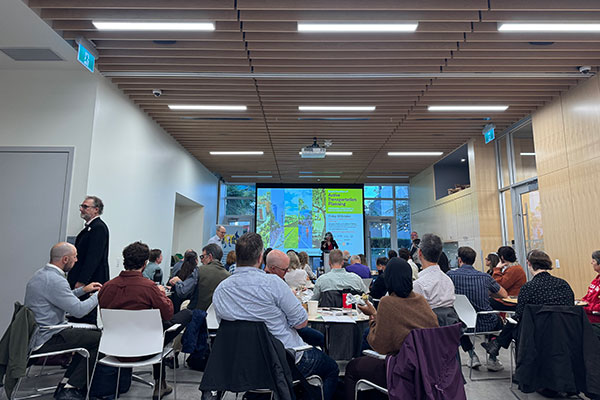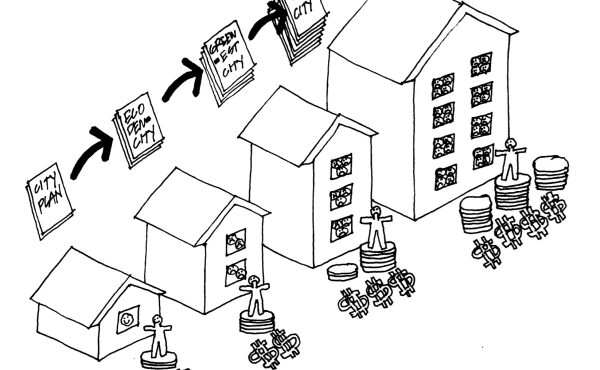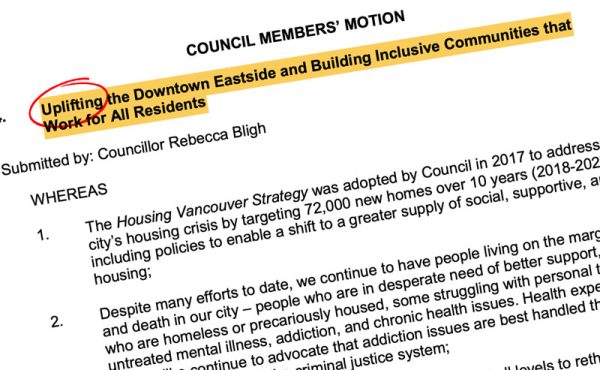
It was a cool late afternoon in October when I met up with Melissa and Chris Bruntlett at Trees Café on Granville Street. The rain held off as we settled at a patio table, immersed in the musicality of the city winding down from a day’s work. Warm mugs of tea in hand, Melissa, Chris, and I dove into the topic that had brought us together: the Bruntletts’ Week of Learning.
The former Vancouverites had planned quite the homecoming after six and a half years away. In addition to launching their new book, Women Changing Cities, they were leading an anticipated week-long itinerary of urban mobility events and workshops across Metro Vancouver. From October 6 to 11, the Bruntletts brought their experience and skillful storytelling to a wide range of audiences and venues, exploring what it means to live in a city that embeds health and choice into its transportation systems—and how those lessons might be applied locally.
Melissa and Chris began their advocacy for cycling back in their Vancouver days—filling a gap in how everyday cycling was communicated to everyday people. Storytelling remains central to their work today, which now spans beyond just cycling to multimodal, connected cities that offer diverse ways of getting around—from foot to bike, wheelchair to train, and everything in between.
A city that enables mobility choice is a city that empowers its people. Melissa and Chris didn’t come to Metro Vancouver to deliver a transportation engineering masterclass, but rather to share lessons in empathy, partnership, and connection as powerful drivers of healthy and inclusive cities.
Lead with Empathy
Empathy: the ability to understand and share the feelings of others.
Empathy was the undercurrent of our conversation—and of every event I attended. In a field so often entrenched in technical jargon and opaque design standards, empathy ripples beneath the surface… disrupting norms and challenging the status quo.
Melissa emphasized, “Empathy isn’t a checkbox—it’s continuous. You have to keep checking your assumptions.” What if, she asked, we sat with the people we’re designing for before offering solutions? “That alone could change half of North American planning.”
This call for empathy must not remain a well-intentioned afterthought—it needs to be embedded in governance structures and policy. Practical applications include co-designing processes, participatory budgets, and grants for community-led projects—ways to share power in implementation, not just solicit feedback.
If a City Works for Children and Caregivers, It Works for Everyone
“Children are a planning metric: if they disappear from public space, the system has failed.”
— Curbing Traffic
Cities may not realize that their most honest and experienced planning consultants are often the ones pushing a stroller—or riding in one. Children and caregivers possess a deep understanding of the environments they navigate, yet they are repeatedly excluded from them. Think of the overly narrow and uneven sidewalks near your home, the street crossings daunting even for vigilant adults in broad daylight… or the prevailing assumption that streets should prioritize the movement and storage of metal boxes over the humans laughing, playing, and breathing life into our cities.
This theme appears in all three of the Bruntletts’ books, and the Week of Learning was no different. The takeaway: value care work, centre the stories and experiences of children and caregivers, and ensure their voices and hands are involved in shaping better streets and cities.
At the professional workshop wrapping up the week, I was especially struck by the final note in Melissa and Chris’s eight recommendations for shifting hearts and minds toward healthy mobility: build a movement that starts with kids.
You could feel the energy shift as that message landed with elected officials, transportation staff, and civic professionals. Could the key to our healthiest cities really lie in something so simple? Valuing our youngest citizens not only as beneficiaries of good design but as insightful contributors to its creation?
Melissa added, “Children are sponges—they absorb everything, good and bad, and come up with solutions unclouded by adult cynicism.” She also reminded us to consider the “invisible” care trips in transportation policy—“the unpaid, off-peak, multi-stop trip chains completed overwhelmingly by women.” That’s the foundation for an empathy- and human-centred community.
Backlash Is Inevitable—Respond With Care
This brings me to my final takeaway, essential for translating these ideas into action: backlash is inevitable. What matters is whether we respond with fear—or lead with care.
What holds cities back isn’t a lack of technical knowledge or even good intentions, but political fear. On this point, Chris was candid: “The moment anything gets backlash, elected officials cancel the project—and that’s the worst possible outcome. It just cements the status quo.”
Opposition to change is often loud—not necessarily large. Elevating the “silent majority”—those who quietly support mobility choice and safe school routes—is key to unlocking lasting, positive change. Melissa and Chris didn’t suggest ignoring critics, but rather grounding decisions in empathy and care for the people and places we call home.
Change is hard—because people don’t like change. The leaders featured in Women Changing Cities can attest to that. Former Montreal mayor Valérie Plante faced vitriol for pedestrianizing commercial streets, and Paris mayor Anne Hidalgo received fierce backlash as she rolled out hundreds of school streets and separated bike lanes, often at the expense of (gasp) parking spots.
Yet today, these once-controversial streets are celebrated—welcoming spaces that foster identity, connection, and local economic activity. Even the harshest critics now enjoy sipping Chardonnay on a patio, basking in a small slice of Montreal’s 9.4 kilometers of pedestrianized streets, accompanied by live music, friendly conversation, and the aroma of fresh baguettes drifting from the bakery next door.
Reigniting the Movement
For Melissa and Chris, the week wasn’t just about the events or promoting their book—it was about reigniting a culture of active transportation in a region that needs a push. When asked what success would look like, Chris replied, “We hope this week can start stitching that coalition back together—because right now, all these brilliant groups are working in isolation instead of strategy.” Melissa added, “If this helps people who are feeling frustrated or tired to feel re-energized—in advocacy, in agencies, in cities—that would be a success.”
The week may be over, but I hope these messages continue to echo through our region and take root in our work. The challenge now is to carry this momentum forward—not as individuals, but as a collective, led by empathy (and, certainly, a few kids) at the helm.
***
Molly Barkowsky is a children’s active transportation specialist shaping joyful mobility for all ages. You can find her at TransLink – or on her bike.




